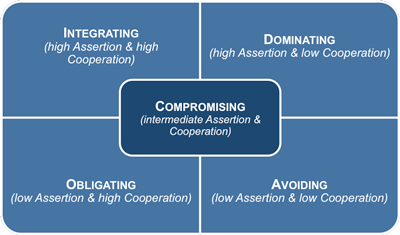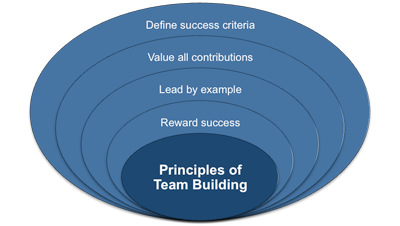Emotional Intelligence, Change, Conflict, and Leadership
Successful managers are often individuals who are open to or seeking new ways to do things and are forward-thinking and open to change as a way of improving themselves and helping others to do the same. Goleman describes this sort of person as a 'change catalyst.'
A change catalyst is someone who recognizes when change is needed and removes any barriers to such change. Such individuals are happy to champion the required change and use their skills to persuade and direct others to ensure its success.
Being willing to challenge the status quo also requires that you are able to recognize conflict and to take action to resolve it as soon as possible. Any conflict can prevent effective communication between team members. It can also kill creativity and productivity by creating unnecessary distractions and encouraging people to behave defensively.
The nature of the modern workplace means that people will generally try to maintain an appearance of harmony, and you need to be attuned to your environment in order to pick up on subtle signs that something is wrong. If conflict is not properly managed it can even cause people to leave the team because very few people enjoy working in a stressful environment.
 |
The first step in dealing with conflict is to realize that it is happening. According to Blake and Mouton's management network, there are two conflict behaviors; cooperation (concerned for others) and assertion (concerned for self). Combining these two types of behavior results in five styles of conflict management:
Avoiding (low cooperation and low assertion)
This is actually the opposite of conflict management and involves simply ignoring the problem. It can be a successful short-term strategy as it gives both sides in the dispute time to examine their own case and to consider carefully what is at stake.
Compromising (intermediate in cooperation and assertion)
This involves searching for a solution that brings some degree of satisfaction to each party in the dispute. The problem with a compromise is that it may not necessarily be the best solution - only one that is acceptable to both parties.
A compromise will only work provided both parties are prepared to discuss their own preferred solution. It is also only effective where there is no strong personal animosity between the parties and that both of them feel that giving something up is worthwhile in order to maintain a working relationship.
Integrating (high cooperation and assertion)
This concentrates on problem solving in a collaborative way. It involves facing conflict directly and trying to find new and creative solutions to problems by focusing on the needs of both parties. This style is perceived as highly effective because it provides each party with access to the other's perceptions and beliefs, which enables them to find a solution that integrates the goals and needs of both.
Obligating (high cooperation and low assertion)
This is associated with attempting to play down the differences and emphasize common ground in order to satisfy the concern of the other party. It can be used as a strategy when a party is willing to give up something with the hope of getting something in exchange from the other party when needed.
Dominating (low cooperation and high assertion)
This involves suppressing the conflict by making it clear that disagreement is not tolerated. It does not examine or address the underlying cause of the conflict and is likely to drive it underground. It can be used when time is limited and when a long-term solution is not that important, either because the team is not going to be together for very much longer or because the source of the conflict is of a transitory nature.
Conflicts involve both facts and feelings and the facts are only part of the story. The real skill in conflict management is to understand why those facts matter so much to the parties involved. This requires an understanding of the underlying emotions as well as the needs of each of the parties. Understanding these gives you a window on their motivation, which enables you to work together to address the conflict in the light of what it is that each party really wants.
Always remember that the issue on the table may actually be a proxy for deeper-seated personal issues. This is why it is so important to build bonds within your team and with other colleagues and associates outside this group.
 |
Those who exhibit a high level of EQ in this area easily make friends and take the time to develop mutually beneficial relationships with an extensive network of acquaintances, both professional and friends. They easily create rapport and have a talent for keeping others appropriately informed to ensure this bond is strong.
There are four key principles in being able to build successful and collaborative teams because you rarely have the opportunity to select your 'perfect' team members. These principles are:
Define success criteria - defining and communicating the team objective so that it is easily understood by everyone and allows all team members to contribute, regardless of their skills and experience.
Lead by example - means exhibiting the same professional behaviors to everyone you interact with, whether they are inside or outside your team. This includes customers and suppliers as well as other people within your organization.
Value all contributions - means that you will need to show that you value each member of the team and that their views matter to you regardless of the role they play. One simple way to exhibit this is by ensuring all views are heard when talking about issues at a team meeting or discussion.
Reward success - you will usually have the ability to reward those team members you are directly responsible for. However, the extent to which you are able to offer truly motivating rewards, especially monetary, will be influenced by your organization's culture and the amount of decision-making power you have.
We have a set of team leadership skills eBooks available and if you combine the skills detailed in these with what you have learned about emotional intelligence from this eBook, then you should be able to build and manage an effective team.
You may also be interested in:
Developing Emotional Intelligence | Self-Awareness | Self-Management | Social Awareness | Relationship Management | Emotional Intelligence, Communication, and Coaching.



